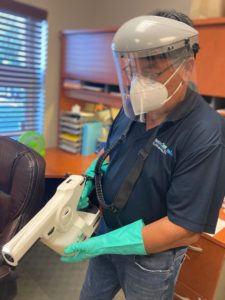
As we reexamine safety protocols to help slow the spread of COVID-19 in long-term care, one building system getting a closer look is ventilation. Some LTC facilities managers now realize that the air filtration systems in their buildings do not adequately remove pathogens.
Installed filters typically have a Minimum Efficiency Reporting Value, or MERV, of six or eight. The Centers for Disease Control and Prevention now recommends MERV 13 or higher filters be installed.
Whether MERV 13 filters work in an existing HVAC system depends a great deal on how old a heating and air conditioning system is. Those more than 10 years old may not have the power to pull and push air through a MERV 13 filter. While adjustments can be made, upgrading to MERV 13 with an older HVAC system can be both costly and complicated.
But another, more affordable focus is facility cleaning.
Most LTC facilities are likely being cleaned and disinfected more thoroughly now than they were a year ago. Many cleaning contractors, as well as staff housekeepers, are turning to electrostatic sprayers.
This is one of the most important tools in the cleaning arsenal to fight this disease. However, there are many questions about these systems, including how they work and why they are so useful.
To help answer those questions, I turned to Michael Wilson with AFFLINK, a leading, U.S. distributor-membership organization and marketer of electrostatic systems. He works with distributors and clients to educate them why to use these systems and how to realize their benefits.
Michael, are electrostatic sprayers a new technology?
No. They were invented in the 1930s but mainly used for industrial applications.
What exactly do they do?
They spray “fog,” or “mist” surfaces with a disinfectant. If the disinfectant is on the N-List, meaning it has been approved by the EPA to eliminate coronavirus pathogens, it should stop the disease’s spread.
Can they be used on all types of surfaces?
For the most part, yes. They can be used on floors, walls, counters, chairs, tables, even wall hangings. However, what is all too often overlooked is that these surfaces must be cleaned first before the electrostatic sprayer can be used. This is usually true whenever we use a disinfectant. The surface must be cleaned first and then disinfected.

When misted, what keeps the disinfectant on surfaces?
Unlike conventional spraying systems, with an electrostatic sprayer, a positive charge is applied to the disinfectant. The positively charged disinfectant is attracted to negatively charged surfaces and wraps around these surfaces, such as those mentioned earlier.
Can the disinfectant be removed by touching or cleaning those surfaces?
It depends on the disinfectant used and the type of electrostatic sprayer used. With some, the disinfectant’s killing power can last as long as 90 days on surfaces and is not removed by touching or cleaning. Because the disinfectant can eliminate pathogens for so long, the process is often referred to as “continuous protection” or “long-term protection” of surfaces from pathogens.
Does the disinfectant used in an electrostatic sprayer eliminate just the pathogens that cause coronavirus?
No. Usually, an antimicrobial disinfectant is used. These are designed to eliminate a wide range of pathogens. An antibacterial disinfectant, on the other hand, is engineered to kill just a few types of pathogens.
Why should they be used in LTC facilities?
There are several reasons. If you are an administrator, housekeeper or cleaning professional working in an LTC facility, stop reading for a second and look around your facility. You will most likely see that there are scores of surfaces that can collect pathogens, and when touched, spread disease. These surfaces are often not cleaned and disinfected, either at all, or as frequently as they should be.
For instance, notice the magazines on the table or the books on shelves. Items like these that are handled by many people can collect pathogens.
The same is true of the following:
- Walkway railings and ledges of all types
- Remote control devices
- Chairs and tables
- Lamp switches (as well as all light switches)
- Sinks, counters, and faucet controls
- Door handles and surrounding surfaces
The list can go on and on.
“For administrators, there are some other things we should know,” adds Wilson. “Because the disinfectant lasts so long, it means these surfaces do not need to be disinfected as often. This is a labor and cost savings.”
Further, it helps prevent disinfectant resistance, according to Wilson. Just as some antibiotics are proving ineffective because they have been overprescribed, so are some disinfectants. Pathogens have become resistant to them. Using fewer disinfectants will help slow this process.
Wilson also points out that as important as they are, electrostatic sprayers are just one cleaning tool we have today to help slow the spread of COVID. LTC administrators should work with their janitorial distributors, learning about other cleaning technologies, products and methods now available to help stop the spread of the disease.
“Dr. Fauci keeps calling the new vaccines the Calvary, coming to save the day,” Wilson says. “Well, in some ways, the cavalry is already here, in the form of janitorial distributors.”
Robert Kravitz is a frequent writer for the professional cleaning industry.



